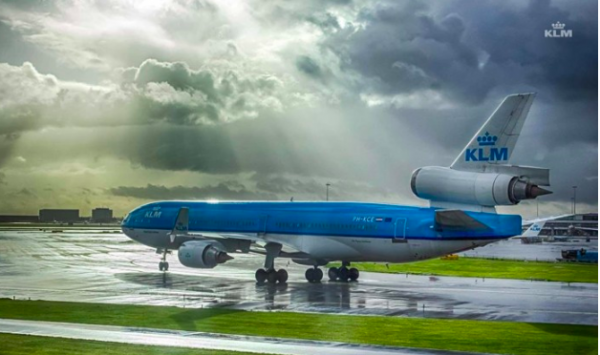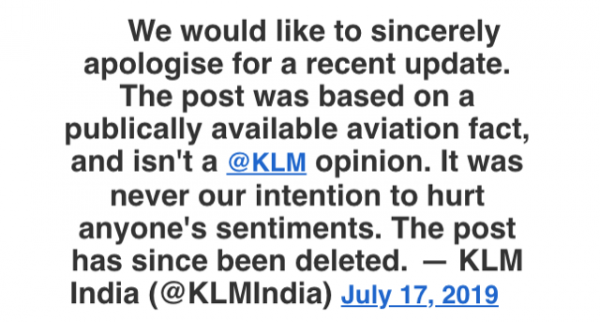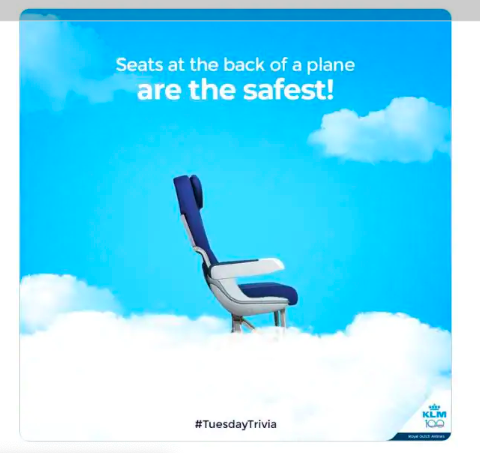MUMBAI, 23 July 2019: While it is nice to get insider tips on getting the most comfortable and safest seats on a plane, Dutch airline KLM went a bit too far last week when it shared on Twitter about which seats are the deadliest.
Admittedly, the Tweet was a follow-up to a trivia question about air fatalities, and KLM’s India office later deleted the post after a strong social media reaction, but what do you expect when you put out: According to data studies by Time, the fatality rate for the seats in the middle of the plane is the highest?
This is from an airline which has over 25 million fans and followers on social media, and a dedicated social media team of 250 service agents worldwide.

“However, the fatality rate for the seats in the front is marginally lesser and is least for seats at the rear third of a plane,” they tweeted with an image of a seat on top of a fluffy cloud, concluding, “Seats at the back of a plane are the safest!”
The posting, while accurate, doesn’t exactly enhance the image of KLM, as no one likes to be reminded about the possibility of dying while flying.
There is a conundrum when it comes to air safety: flying on a commercial airlines is the safest form of transport there is, but when planes do crash, they dominate the news, particularly when the accidents are ‘unsurvivable’ such as last year’s Boeing 737 Max crash into the Java Sea shortly after taking off from Jakarta. The incident, and an Ethiopian Airlines crash in March this year, led to the grounding of Boeing’s 737 Max 8 planes worldwide.
Last year was regarded as a ‘bad’ year for plane crashes. More than 500 people died in passenger airline crashes. Despite the high number of fatalities – the LionAir accident was the deadliest incident for the year, claiming 189 lives – it was still the 9th safest year in the history of air travel. The previous year – 2017 – was the safest in history for commercial air carriers with no passenger plane crashes.
Three times as many people died around the world in road accidents last year in just one day. Yes, it’s true the adage that you are more likely to die crossing the road or driving to the airport than on a plane. According to the World Health Organisation, in 2010 the equivalent of a Boeing 777 with 320 souls on board dies on ASEAN roads every single day. You are more three times more likely to die in a shark attack than in a plane crash.

However, in 2014, in the three crashes by Malaysian and Indonesian planes, all passengers and crew lost their lives. Everyone who died in 2014 on commercial airlines around the world was killed flying aboard airlines from the East – more than the annual fatalities in 2011, 2012 and 2013.
What are your chances of being in a crash? The accident rate is one fatal accident for every 2.5 million flights. But there is no ‘safest’ seat, according to the Federal Aviation Administration, as it depends on the type of crash – whether it be a nosedive, a water landing or collision on the runway.
Despite the impression that when a plane crashes, no one gets out alive, the US National Transport Safety Bureau says 95% of all accidents do have survivors.
KLM was correct in specifying the safest and deadliest parts of the cabin. The back of the plane, which is always the cramped economy class section, full of screaming babies, unruly families and overweight passengers, is often regarded as the worst place to be on an aeroplane from a comfort point of view.

It is too close to the gossiping flight attendants in the galley, too close to the smelly lavatories and queues, too far from the forward exit to deplane.
Other studies have suggested that the very worst seats in the plane – middle seats near the back – are the safest. So if you ever have to walk past the smug passengers lounging in First Class and the ‘more-important-than-you’ vibes from Business Class, on your way to your assigned middle seat in the back of the plane, you can take some comfort that while those in premium have less than 50% chance of survival, according to a 36 year study of US commercial plane crashes in Popular Mechanics published in 2007. If you are seated behind the trailing edge of the wing, you statistically have 30% more chance of surviving than those up front.
The more recent 2015 Time study cited by KLM examined accidents and seating charts back to 1985 and found a similar pattern with the rear third of the plane having less than 1-in-3 chance of dying in an accident while those seated over the wing and the front third of the plane were nearly 20% more likely to die.
But can you take any comfort from the fact that the front of the plane is likely to suffer first from the impact on hitting the ground or water, or that as the wings snap off, you can be sipping your drink for a millisecond longer sitting in the back of the plane?
But isn’t it being a little fatalistic in choosing your airline seats based on the likelihood of dying in a crash? Given the almost all flights do get from A to B, without any drama, safety should be lower on the list of priorities for seat selection, behind comfort and space. After all, the odds of perishing in a plane crash are into the millions.

KLM’s social media blopper, while highlighting the safest seats, threw attention of the fears of fliers. “I’m not sure this is the selling point your brand wants or needs,” said one commenter on Twitter.
For the record, KLM, the oldest airline in the world still operating under its original name, is regarded one of the safest airlines in the world, and last year achieved high ratings for safety and punctuality. It hasn’t had a fatality for the last 25 years, according to Airsafe.
The safety record of Asian’s airlines has been dented by accidents in Indonesia and Malaysia in recent years (including the disappearance of MH370), with Airline Ratings site ranking Indonesian carrier Trigana Air Service among the lowest, along with four Nepalese airlines Buddha Air, Nepal Airlines, Tara Air and Yeti Airlines. In 2014, South East Asian and Pacific airlines averaged 2.2 significant accidents per million flights, three times higher than North Asia. A shortage of pilots and engineers, poorly trained pilots, insufficient infrastructure, and slipping safety standards may be putting the public at risk, according to aviation experts.
In 2017 when an Air Asia flight from Perth to Kuala Lumpur started shaking after a loud explosion, the pilot of the Airbus A330 admitted to the 359 passengers he was ‘scared’ and recommended they pray. The pilot was later praised for keeping passengers calm, though the online video shows scenes of panic.
With budget airlines accounting for half the flights across South East Asia, many have signed up to IATA’s Operational Safety Audit Program (IOSA), introduced in 2003 to address airline accidents attributed to simple processes and maintenance programs. Participating airlines have a three-fold better safety record than those that do not do the audit.
The region’s growth is demonstrated by Asia-Pacific taking delivery of more than 40% of new aeroplanes in 2014.
Southeast Asian carriers who have signed up to IOSA include Vietnam Airlines, Bangkok Air, Thai Airways, Thai Smile, Singapore Airlines, Orient Thai, Philippine Airlines, Malaysia Airlines, Garuda Indonesia, Royal Brunei and Myanmar International. AirAsia and AirAsia X, along with Vietjet and Lion Air are now on the registry.
For Lion Air, which is a relatively new airline but is expected to be one of the largest airline groups in Asia, the 2018 crash came 18 months after the airline had passed the industry standard for airline operational safety, the IOSA. It was the first major accident for Southeast Asian carriers since the Indonesian AirAsia crash in December 2014, which killed 162 people. The Lion Group, which has five airlines in South East Asia based in three countries – Indonesia, Malaysia and Thailand – has a larger fleet now than AirAsia and AirAsia X. Along with many other Indonesian airlines, it was formerly banned and blacklisted by the EU in 2007, following many accidents and unaddressed safety concerns. An industry expert says every year between 2010 and 2015, Indonesia had an incident where a plane had to be written off every year. The ban for all Indonesian airlines, including LionAir, was lifted in mid-2018.
Within a day of KLM’s Tweet about where in a plane you are most likely to survive a crash, an apology was offered. “The post was based on a publicly available aviation fact and isn’t a @KLM opinion. It was never our intention to hurt anyone’s sentiments. … “KLM apologizes for any distress the tweet may have caused.”
A spokesperson for KLM said the Indian-based social media team’s post was an industry reality, and not the airline’s opinion or advice. Manel Vrijenhoek said, “We will be reviewing our Twitter protocol to ensure appropriate content better.”
KLM currently serves Delhi and Mumbai, with plans to expand services to Bangalore.
While passengers may worry about the possibility of something going wrong on a plane, fearful flyers are reminded to think instead about the probabilities.

Keith Lyons (keithlyons.net) is an award-winning writer from New Zealand, based in Asia. ‘Opening Up Hidden Myanmar’ (Duwon Books) along with his writing and photographs contributed to ‘The Best of Myanmar: The Golden Land of Hidden Gems’ (KMG) will be published shortly.






